Editor: Maureen has recently joined NWSSA. You may have met her at Camp B last year, or read her Nov/Dec 2006 Sculpture NorthWest article about the carving she did in Italy. Here is a little more about Maureen; her life and work in Port Angeles.
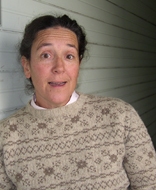
SN: Who are you?
MHW: I am Maureen Hope Wall; I am an artist.
SN: What is your life history as it relates to being an artist?
MHW: I first found sculpture when I was a kid and we came to the Pacific Northwest for our summers. I would play with the drift wood on our beach, making sculptures out of what I saw. Even though I had been drawing and painting by that time in my life, I knew that sculpture was more exciting and engaging.
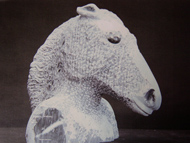
SN: Why did you become an artist?
MHW: My father encouraged me to study art; he saw life as very romantic. I think if he had known about the struggles I would face as a woman and as an artist, he might have encouraged to go a different direction.
SN: What life experiences affected your direction in art?
MHW: My art direction was very much affected by where I went to school: I began to study at the Art Students League in New York City, Which, if you've never been there, is a great place. Anyone can go, it's like going to a gym for artists. It’s a place to work out; it has live models, and some great artists teaching the basics: painting, drawing, sculpture. That set the tone and I continued my studies, in a traditional way, at the Pennsylvania Academy of Fine Arts.
SN: Who or what has influenced your art form?
MHW: This kind of study I mentioned before never left me, even when I entered into the less traditional art education of the university. When I studied art, my method of choice was to find art in the dumpster. Very few of the students cared about how to make something from "scratch." I think the lack of that ability is very limiting for artists. In fact, I believe it was the painter Frank Stella who said he was sorry that he'd never learned to draw. So I use the history of art and its historical processes to fabricate my work and also to give it meaning.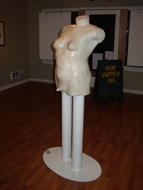
SN: Why is art important to you?
MHW: I think when you do something you love for 25 or 30 years you shouldn't give it up. I chose art as a career because I believe art is where the history of the world is written.
SN: How does your art reflect your philosophy?
MHW: My work is about human beings, the body as frontier or facade for constructs and ideologies. My work is also about history. Some of this history is of my own making; I use creativity in the service of dreams to create an alternative scenario. It's a dialogue with the surface and what lies beneath that surface.
SN: Describe your art in your own terms – focusing on your stone carving.
MHW: Well, besides what I've already told you, stone is a very traditional means of making sculpture, and hence a great way to speak directly to that history, art, stone carving, and to human beings.
SN: Is your art representational and/or non- representational?
MHW: It is very representational.
SN: Just how do you get your ideas?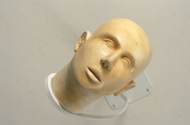
MHW: From working a lot. My students make the mistake of thinking each time they set chisel to stone or pencil to paper they’re making art. Some get scared that what they're doing isn't a great enough idea, or that they could in some way “wreck it.” It’s more in the process that art happens, but that does not mean that each thing you eke out should be framed as art.
SN: How do you develop the ideas you get from working a lot. Do you use direct carving, drawing, modeling, or something else?
MHW: I have small stones that I carve and mono-prints and drawing to help move ideas along. but I don't have models that I then carve into stones. I carve right into the stone and use proportion and calipers to help me work figures that look "realistic."
SN: What is the source of inspiration of your forms, language, or imagery?
MHW: History and our bodies.
SN: What are you trying to express in your art?
MHW: I'm searching. Creating dialogue between surface and what lies beneath. Like probing a wound.
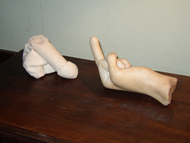
SN: Describe a recent piece or two.
MHW: I was working on a piece of pink Portuguese marble this summer at Camp Brotherhood, you may have seen it. It’s finished now and I call it “Polyp.” Pink breast/scrotum, rounded forms like a sea creature, or a tumor, I’m not sure. There is a long silk cord covering the cable which keeps the piece suspended. It can attract you and repel you at the same time.
SN: Do you work part or full time as an artist?
MHW: I try to work full time as an artist but I've found that very difficult in the U. S. there is not as much respect for art or artists here. I teach drawing and clay sculpture and stone carving at my studio here in Port Angeles.
SN: What stones do you prefer?
MHW: I choose stones for different reasons so I can't say that there are stones that I prefer over others. Reasons like - the color of a stone can be part of the metaphor that speaks in the piece, or where a stone comes from, or how hard it is.
SN: What is your working process – do you do one piece at a time or do you have several in process at once?
MHW: I have many pieces going at a time and it takes me a long time to finish a work.
SN: Where do you exhibit your work?
MHW: I've exhibited around in Europe and here in the states, locally at the Port Angeles Fine Art Centre and I'm in a show at the Tacoma Community College in January, called “Contemporary Baroque.”
SN: Have you been influenced by any particular artist?
MHW: I let a lot of art influence me. I have a favorite quote from Breten Breytenbach, "You have to spike the self incessantly, you have to probe and prod the numbness, you must pickle the heart, you have to resist, you have to fight the leveling or the burying and the forgetting brought about by commonplaces."
SN: What obstacles and challenges have you overcome?
MHW: The other day I was taking stock of my three years here in Port Angeles with a great artist, and friend of mine. We figured that things were better this year than they were last year, progress had been made. The way we judged that, was, there were more people in town who hated me this year than last. It may be because I’m tall that people have difficulty with me (not, me with them). I feel that I have so much to offer, I’ve studied with some amazing sculptors in some amazing places. Yet here in this small town most people are .....
SN: How is your work area set up?
MHW: When I first came to this area I bought an old Odd Fellows Lodge which I’ve been restoring. The building is about 11 thousand square feet on three floors. There is a ballroom (which is over 1,500 sq. ft.) where I work on paintings and prints and when it’s cold I work on clay sculptures up there. Then the basement is for dirty arts, like plaster, mould making, stone and wood carving. I dream to someday have a printmaking shop down there. The problem is getting the community to participate and use these spaces also.
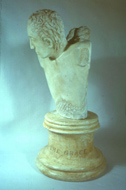
SN: What are you looking forward to?
MHW: I’m looking forward to having the basement finished and my compressor installed. I dream of someday have printmaking, clay and plaster studios down in the basement along with the stone carving, all functioning with great participation from the community. It’s a tall order but I think if you can imagine it, it can come true.

